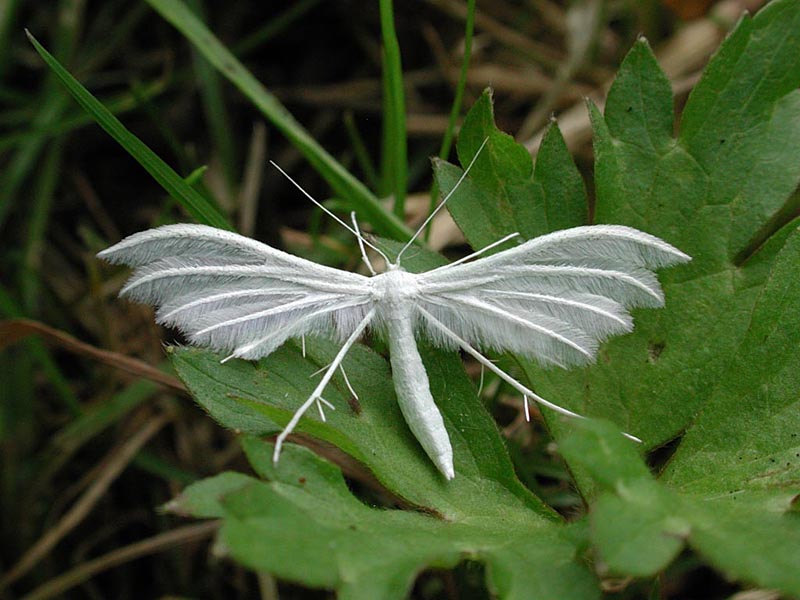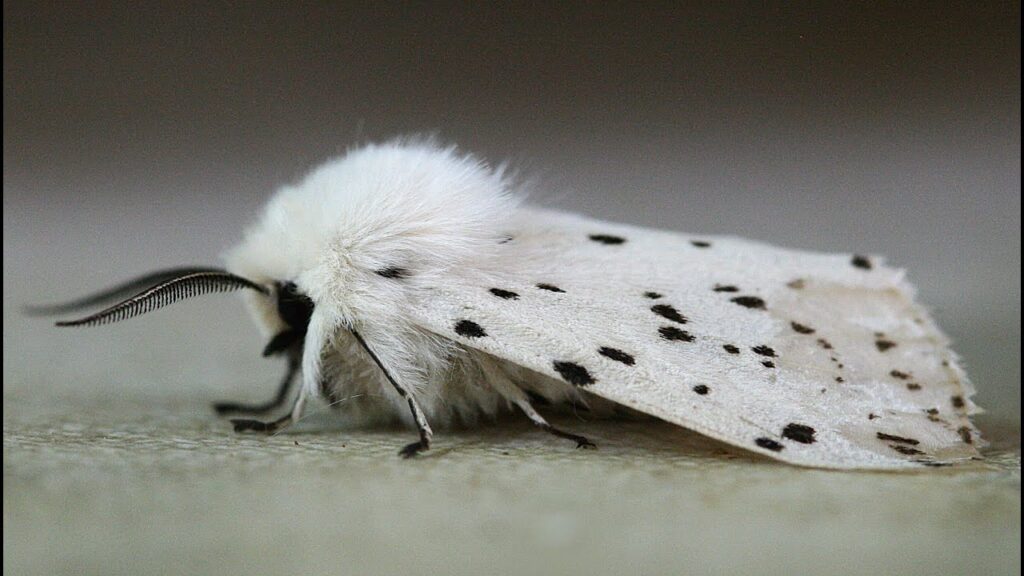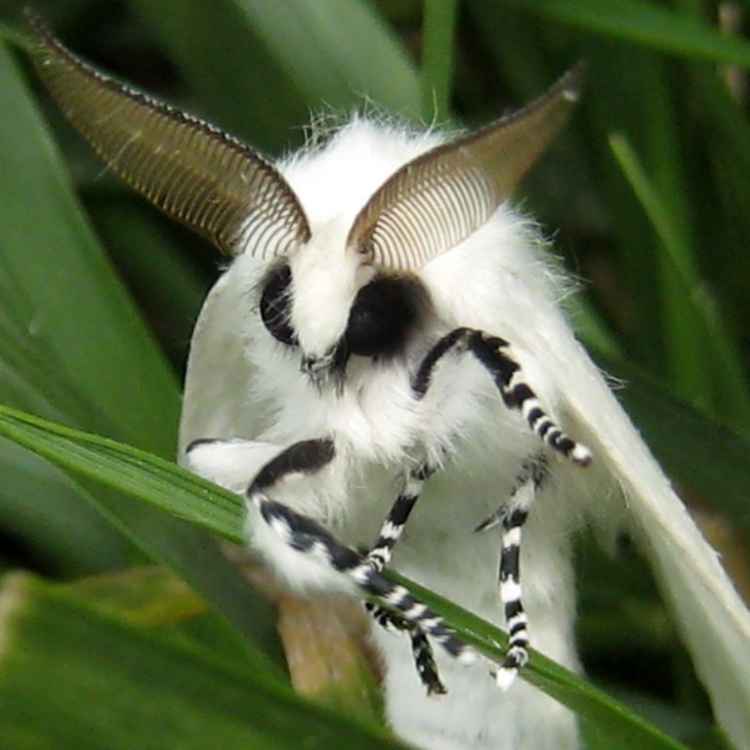White moths mostly eat nectar from flowers. You can often see them flying around flowers and using their long, straw-like mouth to sip nectar, which gives them the energy they need to fly and do other things.
Some white moth types might also drink other liquids like tree sap, old fruit juices, or the sweet liquid made by aphids and other bugs called honeydew. But moths usually don’t eat solid food like caterpillars do, because when they grow up, their main job is to find a mate and have babies.
What do white moths eat for energy?
White moths, like many other moth species, primarily feed on liquids. Their diet mainly consists of nectar from flowers and occasionally includes other liquid sources. This diet is crucial for their survival and reproductive success.
Nectar from Flowers
Description of Nectar Feeding Behavior: White moths, like butterflies, are equipped with specialized mouthparts called proboscis, which are adapted for sipping liquids. When feeding on nectar, they extend their long, flexible proboscis into the flower’s nectar-containing structures, such as the nectaries.
Moreover, they then use a combination of capillary action and muscular contractions to draw the sugary nectar into their mouths. This feeding behavior is highly adapted for extracting and consuming nectar efficiently.
Role of Nectar in Providing Energy: Nectar serves as a crucial source of energy for white moths. It is rich in sugars, primarily sucrose, glucose, and fructose, which provide a quick and easily digestible source of carbohydrates.
In addition, these sugars are rapidly metabolized in the moth’s body, releasing energy that fuels their flight, mating activities, and other essential life processes. Nectar also contains small amounts of essential nutrients, including amino acids and vitamins, which can further contribute to the moth’s overall health.
Liquid Sources Other Than Nectar

White moths may also consume liquids other than nectar, depending on their environmental conditions and dietary preferences.
Tree Sap: Some white moth species have been observed feeding on tree sap. Tree sap is a sugary liquid that exudes from wounds or openings in tree bark. Moths use their proboscis to access and feed on this sap.
While not as common as nectar feeding, tree sap can provide an alternative energy source, especially when nectar sources are scarce.
Rotting Fruit Juices: White moths may be attracted to the sweet, fermented juices of overripe or rotting fruits. These juices contain sugars that can sustain them, although this source is less reliable than nectar.
Rotting fruit juices may also provide essential nutrients and trace compounds that benefit the moths.
Honeydew from Aphids and Other Insects: Some white moths, particularly those in their larval stage (caterpillars), may feed on honeydew. Honeydew is a sugary excretion produced by aphids and other sap-feeding insects.
Furthermore, moths that feed on honeydew are often associated with ants, as ants are attracted to the sweet substance and may provide protection to the moths in exchange for access to honeydew. Honeydew can serve as an additional source of sugars and nutrients for white moths.
Why do white moth species have different diets?
White moths belong to a diverse group of insects known as Lepidoptera. Within the Lepidoptera order, there is a considerable range of species diversity.
Moreover, several factors contribute to the diversity of white moth species, including geographical distribution, ecological niches, and evolutionary adaptations. Here are some key explanations:
Geographical Distribution: White moths are found in various regions worldwide, from temperate to tropical environments.
Moreover, different geographic areas may support different plant species, which, in turn, influence the availability of nectar and other food sources.
This geographic diversity can lead to the development of distinct white moth species.
Ecological Niches: White moths have evolved to inhabit a wide range of habitats, including forests, grasslands, and urban environments.
Furthermore, each habitat presents unique challenges and opportunities for feeding and survival. Moths that adapt to specific ecological niches may develop specialized feeding habits.
Evolutionary Adaptations: Over time, white moth species have evolved to exploit various food sources efficiently. Natural selection has favored adaptations that allow them to access and utilize specific plants or other liquid food sources.
In addition, these adaptations can include proboscis length, mouthpart structures, and behavioral traits related to feeding.
Variations in Feeding Habits Among Different Species
White moth species exhibit variations in their feeding habits based on their evolutionary history, ecological niche, and available food sources. Here are some examples of feeding habit variations:
Generalist vs. Specialist Feeders: Some white moth species are generalists and can feed on a wide range of flowering plants, while others are specialists, with specific preferences for particular plant species.
Generalists have a broader diet, enabling them to adapt to various environments, whereas specialists are finely tuned to specific plant species.
Diurnal vs. Nocturnal Feeders: White moths can be further classified based on their feeding activity patterns. While most white moths are nocturnal and feed on nectar from flowers that bloom at night, some are diurnal and feed on daytime-blooming flowers. This divergence in activity patterns can reduce competition for food resources.
Alternative Food Sources: In addition to nectar, some white moth species have developed the ability to feed on alternative liquid food sources, such as tree sap, rotting fruit juices, or honeydew from aphids. These adaptations can help them survive in ecosystems with limited nectar sources.
How and why do some moths change their diets?
While many moths primarily feed on nectar, there are several notable exceptions and variations in their dietary preferences.
Furthermore, these exceptions can be attributed to a range of factors, including ecological niche, evolution, and adaptation.
Fruit-Piercing Moths: Some moth species, such as the Calyptra family, are known as fruit-piercing moths.
Moreover, they have specialized mouthparts adapted for piercing fruit skin, allowing them to feed on the juices of ripe fruits. These moths can be agricultural pests, as they damage fruit crops.
Blood-Feeding Moths: There are a few moth species that have developed the unusual behavior of feeding on the blood of vertebrate animals. The vampire moth (Calyptra thalictri) is an example.
In addition, they use their proboscis to pierce the skin of mammals and birds, feeding on their blood. This behavior is relatively rare among moths.
Mycophagous Moths: Some moths have adapted to feed on fungi. These mycophagous moths, such as the owlet moth family Noctuidae, are often associated with mushrooms and other fungal growth. Their caterpillars feed on various fungi species.
Factors Influencing Dietary Differences Among Moths
Several factors contribute to dietary differences among moths:
Evolutionary History: Moths have evolved over millions of years, and their dietary preferences have adapted to the available food sources in their environments. Evolutionary pressures shape their feeding habits.
Ecological Niches: Moths occupy a wide range of habitats, and their diet often aligns with the plant species or other resources found in those habitats. Moths that specialize in particular niches develop unique diets.
Mouthpart Adaptations: The structure of a moth’s mouthparts, such as the length of the proboscis, determines its ability to access and consume different food sources. Moths with specialized mouthparts can exploit specific food resources.
Competition for Resources: Competition with other insects, including butterflies and other moth species, can influence a moth’s diet. Moths may evolve to utilize underutilized or alternative food sources to avoid competition.
Environmental Changes: Environmental factors, such as climate change and habitat alteration, can affect the availability of food sources for moths. Some moths may adapt by shifting their diets in response to these changes.
How Diet May Change at Different Life Stages?

Moths often exhibit changes in their diet at different life stages, particularly between their larval (caterpillar) and adult stages:
Larval Stage: Moth larvae (caterpillars) are typically herbivorous, feeding on plant leaves, stems, or other plant parts. They often have specialized adaptations for feeding on specific plant species.
Pupal Stage: During the pupal stage, moths undergo metamorphosis inside a cocoon or chrysalis. They do not feed during this stage, relying on energy reserves accumulated as larvae.
Adult Stage: Adult moths primarily feed on nectar, but this can vary depending on the species. Some may switch to alternative food sources, like rotting fruit, tree sap, or even blood, as mentioned earlier.
FAQ’s
Is a white moth good luck?
White moths are often considered symbols of purity and spiritual significance in various cultures. Some people believe they bring good luck, while others associate them with messages from the spirit world.
Which moth is white?
Many moth species can be predominantly white, such as the “Cabbage White Moth” (Pieris rapae) and various members of the “Geometridae” family, commonly known as “white geometrid moths.”
What does a white moth look like?
White moths typically have white or pale-colored wings, but their appearance can vary depending on the species. They may have various markings, patterns, or subtle shades of color on their wings.
Can I touch a tiger moth?
While you can physically touch a tiger moth if you encounter one, it’s essential to handle them gently and avoid harming them. Tiger moths, like many moths, are delicate insects.
What does the moth symbolize in Islam?
In Islam, moths are generally not specifically symbolized or mentioned. However, interpretations of symbols and their meanings can vary among individuals and cultures.
What does it mean if a moth visits you?
The significance of a moth visiting you can vary based on personal beliefs and cultural interpretations. Some people may see it as a spiritual message, a reminder of transformation, or a symbol of the soul’s journey, while others may simply view it as a natural occurrence.
Final Words
In conclusion, our exploration of the dietary habits of white moths has shed light on the fascinating world of these nocturnal insects. White moths, like many other species within the Lepidoptera order, primarily feed on nectar from flowers, utilizing their specialized proboscis to extract the sugary liquid.
However, we’ve also uncovered the adaptability of these moths, which allows them to diversify their diet by consuming tree sap, rotting fruit juices, or honeydew from insects when environmental conditions demand it.
Moreover, we’ve seen that there are exceptions and variations in their diets, with some moths evolving to pierce fruits or engage in mud-puddling behaviors.

